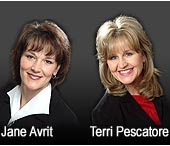DFW Real Estate - Going Green
Terri Pescatore and Jane Avrit with The PescatoreAvrit Team Keller Williams have given advise of ways to prepare your home to sell, such as setting the correct price and using a stager for appearance, but how about implementing some energy and water-saving options too. Many buyers will ask to see past utility bills for a home, and especially with today's increasing prices. Taking measures to reduce these costs might help a buyer to decide on your property verses another. Here are some easy projects that can increase a home's value in a buyer's eyes during a time of high energy costs:
-Replace regular light bulbs in permanent fixtures with compact fluorescent light bulbs. CFLs use about one-fifth as much energy as regular bulbs, and last about 12 times longer. I personally use these bulbs in my home and have noticeable difference in the electric bill. For example:
If you take 100 watt incandescent bulb and replace it with a 10 watt fluorescent bulb, which puts out about the same amount of light, you're saving 90 watts. If you run THAT bulb for 5 hours a day you are saving 450 watts per day. (90 saved x 5hrs) 450 watts saved x 30 days = 13,500 watts per month saved, divided by 1000 = 13.5 kilowatt hours saved for THAT bulb. If it costs .16/kilowatt hour you're saving $2.16 a month in usage for THAT one bulb. If you have several bulbs in your home you can see that this figure can become quite significant. In addition to the kilowatts saved, incandescent bulbs also generate more heat than fluorescent bulbs thus making the fluorescent bulb an optimal choice as far as air conditioning goes as well.
-Install low-flow showerheads, which will save on water heating and use
-Install an Energy Star-qualified, programmable thermostat
-Close the damper on the fireplace - this is often forgotten and can cause drafts and high energy loss
-Add insulation to the attic
-Insulate water heater tanks for energy savings.
-Repair water leaks in tubs, showers and sinks - not only will this save water, but a leak really shows the home is not cared for.
-Perform duct sealing or hire a contractor - 20% of the air that moves through the duct system is lost due to leaks, holes and poorly connected ducts.
-Replace regular light bulbs in permanent fixtures with compact fluorescent light bulbs. CFLs use about one-fifth as much energy as regular bulbs, and last about 12 times longer. I personally use these bulbs in my home and have noticeable difference in the electric bill. For example:
If you take 100 watt incandescent bulb and replace it with a 10 watt fluorescent bulb, which puts out about the same amount of light, you're saving 90 watts. If you run THAT bulb for 5 hours a day you are saving 450 watts per day. (90 saved x 5hrs) 450 watts saved x 30 days = 13,500 watts per month saved, divided by 1000 = 13.5 kilowatt hours saved for THAT bulb. If it costs .16/kilowatt hour you're saving $2.16 a month in usage for THAT one bulb. If you have several bulbs in your home you can see that this figure can become quite significant. In addition to the kilowatts saved, incandescent bulbs also generate more heat than fluorescent bulbs thus making the fluorescent bulb an optimal choice as far as air conditioning goes as well.
-Install low-flow showerheads, which will save on water heating and use
-Install an Energy Star-qualified, programmable thermostat
-Close the damper on the fireplace - this is often forgotten and can cause drafts and high energy loss
-Add insulation to the attic
-Insulate water heater tanks for energy savings.
-Repair water leaks in tubs, showers and sinks - not only will this save water, but a leak really shows the home is not cared for.
-Perform duct sealing or hire a contractor - 20% of the air that moves through the duct system is lost due to leaks, holes and poorly connected ducts.

